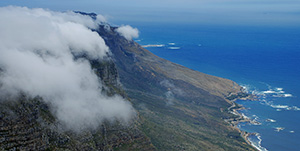
As you might be aware, I went on vacation to South Africa in February with my family to celebrate my mom’s birthday. There’s not need to focus on numbers — or at least that’s what she would say ;) — but let’s just say that it was her 3Cth (hex) birthday. Anyhow, I’ve finished processing the photos from my trip to South Africa and I’ve posted those at Flickr.
I was also pleased to be able to make use of my new camera, a Nikon D80 that I had bought just a few weeks beforehand. I went with the 18 - 135 mm kit lens at the time and it worked out great. I’ll probably buy a faster lens at some point (this one is F3.5 - 5.6) — or maybe even one of those fancy vibration reduction lenses — but I wasn’t about to start dropping big money on accessories right after the purchase of the body & kit lens.
I was away for about two weeks and I took 110 shots. I selected about 60 of those to process and, in doing so, whittled down the list to 35. It’s not that I don’t like processing photos — once I get going, I find that it can have an almost zen-like quality — but some of them just didn’t work out for one reason or another. Most often, one of those reasons was that I ended up blowing out my highlights for one reason or another. Put another way, once you hit pure white (255, 255, 255), you’ve lost all color information for that pixel and even if the image as a whole is darkened (such as to correct exposure), that pixel can only become grayer.
For example, if you’re taking a shot from within a darkened restaurant that happens to include one of its windows, you’ll probably end up with a big ol’ block-o-white where that window would be since the camera is attempting to set its exposure based on the rest of the (darkened) scene. Or, in my case, you might be taking some shots from within a museum that happens to include a handful of skylights (to name just one example). Dangit. I guess when your colorspace has “only” 256 shades of gray, there’s not much you can do. (Maybe shooting RAW might help?)
PS I offer a tip of my hat to Scott Kelby’s book, “The Photoshop CS2 Book for Digital Photographers” — though I’ve been making use of image editors for years, I hadn’t extensively used Photoshop up until I started processing these photos. The book is very down-to-earth and has screenshots every step of the way; I recommend it highly.
Standard photo-entry text: All my photos are released under a Creative Commons license which roughly states that you’re free to “copy, distribute, display, and perform the work”. Also, I’ve resized all the images to 1024-width before uploading them as it can be a bit hard to get your head around a full 10.2 MP image. However, if you want the full-resolution version of any images, just ask.
Incredible pictures! The ocean shots reminded me of the Na Pali coast in Kauai. Thanks for posting them.
I’m glad you enjoyed them, Keith — you have some nice shots, yourself :).
1) Purchase Thom’s Guide to the D80. It’s worth every penny.
2) Shoot raw for everything. It’ll save you many many times.
3) Buy a copy of Bibble Labs to do your raw processing.
4) Get a nice big flash card. :)
Thanks for the tips, Nate!
By chance, do you know if there’s any truth to the comments in that blowing-out-highlights thread that the “D80 exposes for shadows and hence irretrievably blows highlights”?
I’ve read where the D80 shoots a little hot, overexposing the highlights. I’ve actually had some good results by going to spot meter, and dialing in a -.3 exposure compensation. The matrix meter is good but sometimes in mixed lighting I find i don’t have as much control. Then there’s white balance….! Switching from film was not as easy as I thought!
Nat: Just to be sure, are you saying that you use -0.3 exposure compensation all the time or that you use it only occasionally?
Sorry..that’s occasionally, most often with available light, esp. when it’s really bright.
Ah, all righty. I may give that a try the next time I go shooting.
[…] For what it’s worth, I made use of raw mode this time (well, RAW + JPEG Fine) and I my shots seemed to have a better resistance to having their highlights getting blown out (a reoccurring problem that I was running into as I was taking shots during my trip to South Africa in February). Then again, the lighting was almost completely different between those shots and these; in South Africa, I was mostly dealing with either bright sunlight or incandescent light, while in Austin I mostly had cloudy days (not that I’m complaining — cloudy days can be very handy for their diffuse light!). […]
[…] really been enjoying my new camera (a Nikon D80) since buying it in January. And other than the occasional blown highlights, I find that it usually […]